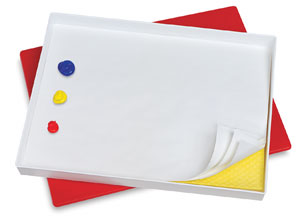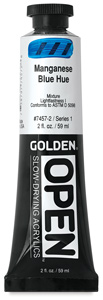How to stop acrylic paint from drying too fast
Reader Question: How do I stop the acrylic paint from drying out too fast when painting outside?
Great question! When you're plein air painting with acrylics, the exposure to the open air can cause the acrylics to dry out even faster than usual - both on your palette and on your canvas. Here are some things you can do to make your acrylic paints stay wet longer while painting outside:
Tips for keeping your acrylic paints moist
- Bring a small spray bottle (also called a mister or atomizer) filled with water so that you can lightly mist your palette with water as often as necessary to keep the paints moist. Distilled water is recommended for best results, but if you don't have any on-hand you can use normal tap water, too.
Use a Stay-Wet Palette, such as the Masterson Sta-Wet Premier Palette (this links to Blick Art Materials, and if you make a purchase I get a small commission that helps support this site). This palette comes with a sponge layer that you dampen and place underneath an acrylic film. You mix your paints on the acrylic film, which stays wet because of the damp sponge underneath.
When you combine the use of a Stay-Wet palette and an atomizer, you'll be able to keep your paints moist from above and from below.
If you need to save the colors you've laid out on your palette for later, replace the lid to securely seal the palette shut. The damp environment inside the sealed palette will keep your acrylic paints moist and usable for days.
If you don't have a Stay-Wet palette, here's how you can make an easy alternative:
Make a pile of 6-10 paper towels, then dampen the stack thoroughly with your atomizer. Squeeze your paints onto the damp paper towels. This will keep your paints moist from below. Spray them with your atomizer as needed to keep them moist from the top.
The absorbency of the paper towels won't allow for easy mixing, so you will need a separate palette for this. To mix colors, use your paintbrush or a palette knife to dab the colors you'll need from your moist paper towels and transfer them onto your palette for mixing.
-
Use an acrylic gel or medium that extends the "open" time of the acrylics, so that the acrylics will stay wet for longer periods of time. These acrylic mediums are usually called "retarders" or "slow-dry mediums", and you'll need to mix these into your acrylics after applying them to your palette.
I've provided links below to the relevant products so that you can easily find them on Blick Art Materials, my favorite online art supplier. I'm a member of Blick's affiliate program, which means if you make a purchase after clicking on one of these links, I'll receive a small commission (at no extra cost to you). Your purchase helps support this site and keeps it free of ads. Click here for more info.
Here are a few acrylic mediums I can recommend that will help keep your acrylic paints wet while working outdoors: Golden Acrylic Retarder, Liquitex Slow-Dri Blending Fluid (or Gel), and Winsor & Newton Artists' Acrylic Slow Drying Medium.
- Instead of spraying your palette with water, spray your palette with Liquitex Palette Wetting Spray as often as you need to keep your paints moistLiquitex Palette Wetting Spray contains ingredients that slow the drying time of acrylics and can be used as often as necessary.
Try painting with Golden Open Acrylics instead of regular acrylics. Golden Open Acrylics are specially formulated to stay wet longer. Many plein air artists have reported great success with using Golden Open Acrylics while working outdoors.
Since Golden Open Acrylics are different from regular acrylics, it might take a learning curve to get used to them, but if you frequently work outdoors they may be something to look into.
- Sketch your composition in pencil or charcoal before you lay out your paints, to minimize the amount of time that the paints have been exposed to the outdoor air.
- Set up your workspace in a shaded area that is protected from the wind, to minimize the effects of sun and wind on your paints.
- If you have a choice, paint outdoors in morning or evening, instead of the afternoon when the sun is at its strongest.
If you make a purchase via the links below I receive a small commission, which helps support this site.
I hope these tips help you keep your acrylics wet while working outdoors.










